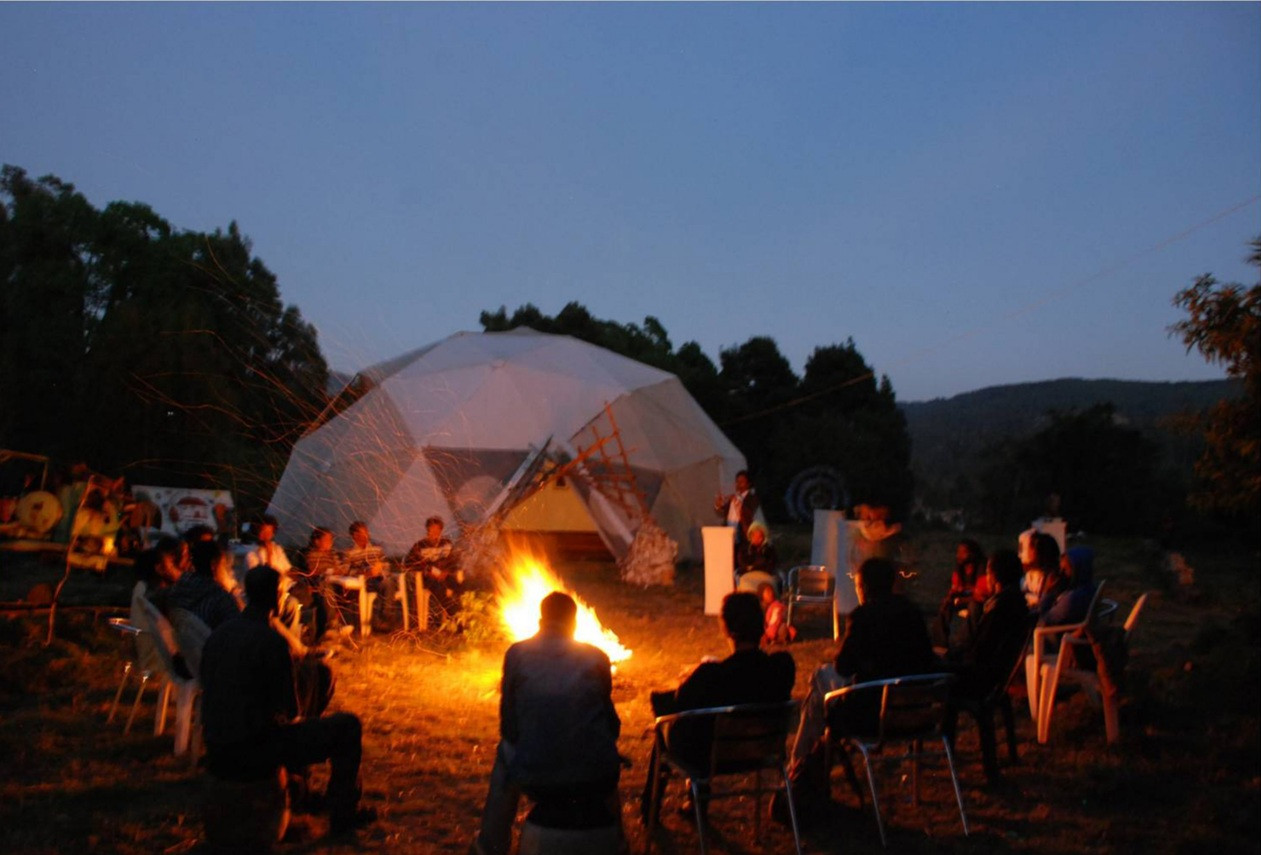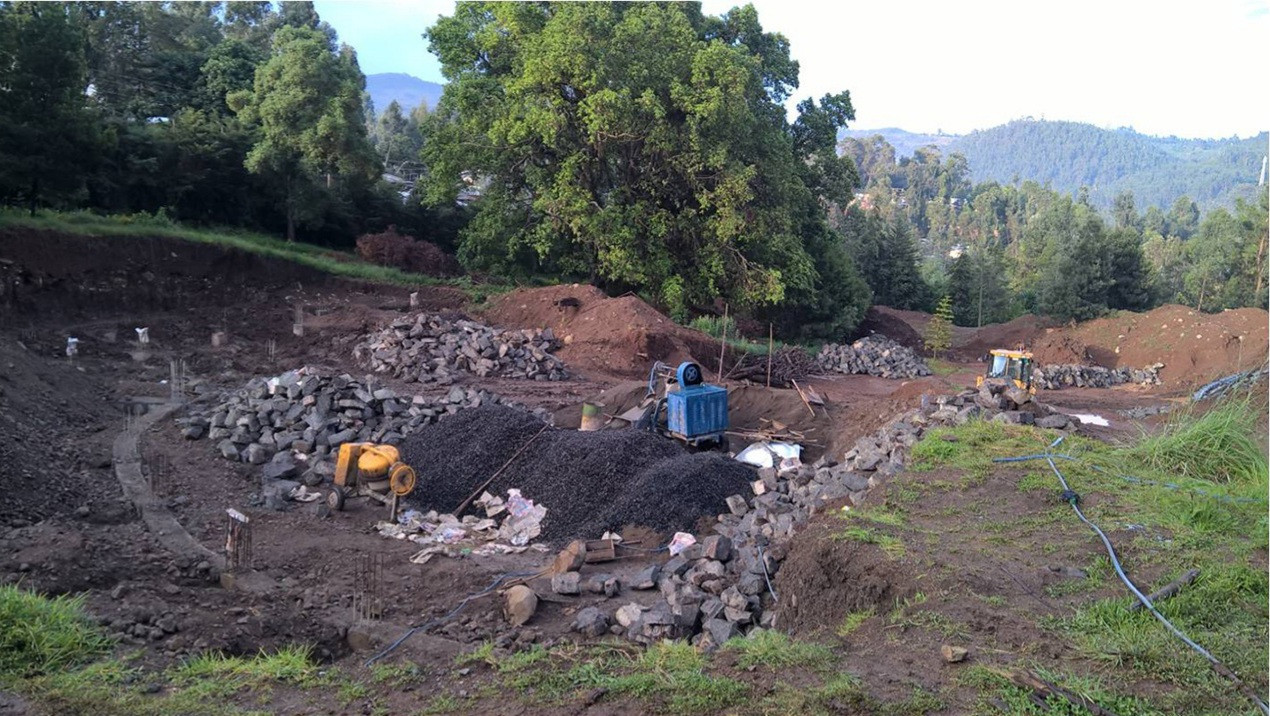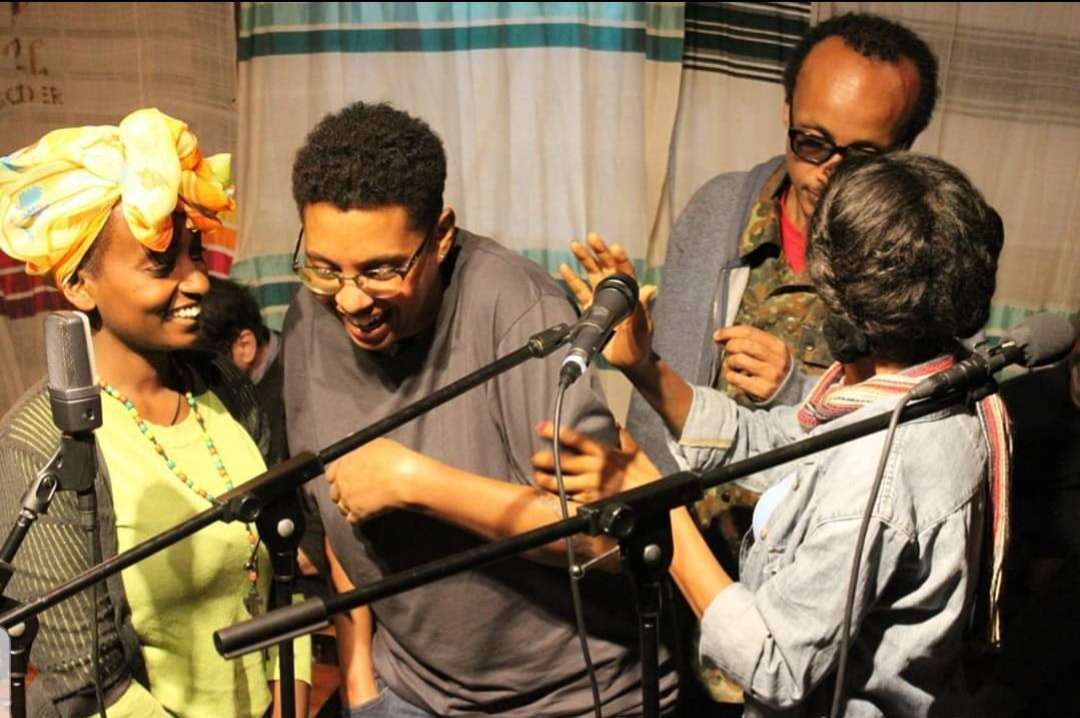Plotform Urbanism: How to do things with Art
April 2, 2024
Addis Ababa, Navigating Friction
April 2, 2024
Addis Ababa, Navigating Friction

Independent art spaces – or offspaces in artworld speak – are shapeshifters that constantly metamorphose in response to accelerated flux and uncertainty. This includes reincarnating into second lives, or sometimes even dying when the time is right. Such redirection, through a dual strategy of refusal and reimagination, is how they sustain themselves to create new infrastructures and contexts that enable other possibilities.
That’s the gist of a multi-city research study, Platform/ Plotform, into the working principles that offspaces in Africa have in common. Built collectively for purpose not profit, it’s less about art per se and more about dialogue, exchange and networks. Taking a cue from John Austin’s book on linguistics, How to do things with Words, offspaces are understood in this study as performatives – like utterances (e.g. “I bequeath”) that not only describe or report; “the uttering of the sentence is, or is a part of, the doing of an action”.1John Langshaw Austin. 1962. How to do things with Words. The William James Lectures delivered at Harvard University in 1955, edited by J.O. Urmson. Oxford: Clarendon Press, p.5. In Platform/ Plotform, it’s about doing things with art. Or DIY-DIT institution-building as artistic practice.2DIY-DIT = do-it-yourself, do-it-together
One exemplar is Netsa Art Village – a former collective and independent art space in Ethiopia, which was closed down a decade ago but continues its artistic thinking in a more ephemeral form. Its fascinating backstory demonstrates second chance – from the founding motivation to location, building materials, and its ultimate fate. Second chance, a form of redirection informed by concepts of repair and recovery, is one of five shared working principles surfaced in my findings. The others are: horizontality which takes collective and rotational form; performativity as mobile agency to say things as well as do; elasticity, a nimbleness that can also require opacity; and convergence, which collapses temporalities to better inhabit a global future. These working principles are in effect ‘panya routes’ – urban lingo in East Africa for self-fashioned back routes or pathways navigated by motorbike taxis (boda bodas, in Kenya) but more generally refers to any kind of get-around or under-the-radar activity.3Panya Routes: Independent art spaces in Africa (2022) expands upon this work.
I posit these working principles as ‘plotform urbanism’, following the growing urban studies literature around platform urbanism.4Sarah Barns. 2020. Platform Urbanism: Negotiating Platform Ecosystems in Connected Cities. London: Palgrave Macmillan. As described by Nancy Odendaal, platform urbanism acknowledges technological agency as relational, intertwined with human and social networks, and creating nodes around which relationships form. It has spatial effects, she adds, and also creates glitches or platform cracks that can be generative.5Nancy Odendaal. 18 August 2020. Platform Urbanism and Hybrid Places in African Cities. Seminar (Zoom), Johannesburg: Cubes – Centre for Urbanism and Built Environment Studies, University of the Witwatersrand. Author’s notes. Plotform urbanism acknowledges artistic agency as relational, imbricated with everyday life and creating transformative nodes. Its effects are also spatial: it can help create new contexts, possibilities, and hence city futures inveigled from paradoxical tensions.

I encountered the story of Netsa Art Village (2008-2014) while doing fieldwork in Addis Ababa for Platform/ Plotform. Zoma Museum was my key Ethiopian case study alongside GoDown Arts Centre in Nairobi (Kenya); ANO Institute of Arts and Knowledge in Accra (Ghana); Townhouse Gallery in Cairo (Egypt), and Nafasi Art Space in Dar es Salaam (Tanzania).6Not all of them are artist-led but artistic thinking is at their heart. However, other offspaces including Netsa cropped up in the research process that helped inform my findings, whichwere essentially surfaced by juxtaposing artistic strategies with everyday urban innovations and then reading across the pan-African case studies for common ground. I first heard about Netsa from Mihret Kebede, an artist and poet whom I met at an academic workshop about Africa as a theoretical category and a prism to examine the contemporary world.7‘Africa as Concept and Method: Emancipation, Decolonization, Freedom’, Workshop hosted by the Consortium of Humanities Centers and Institutes, held at the Alle School of Fine Art and Design, Addis Ababa University, January 2019. Kebede was busy completing their PhD at the Academy of Fine Arts Vienna, on the topic of silence. This idea resonated with the refusals by offspaces that I had already observed in action. We sat down in a traditional coffee shop to discuss Netsa’s birth and ostensible death. Our conversation was interspersed with the greetings of passersby who recognised the artist and shared a few words.
Netsa was an artist-run space started by recent graduates from Addis Ababa University’s Alle School of Fine Arts and Design. It was located inside Ferensay Park, a large green space in the city about three kilometres from campus. The artist collective took over the location from Asni Gallery, which had closed down. Over three to four months, they collectively built its physical structure – including gallery and office – from leftover material found in the park. The structure had a geodesic dome, designed by an architect friend. The fabric covering the dome was sourced using a grant from the Goethe-Institut, a German cultural association. Netsa Art Village became a forum for networking, communication and exchange, self-described as a ‘living museum’ of contemporary art where practice and process could be made visible and shared in situ.
Netsa’s stated objective was in part to anticipate new artistic tendencies and evolutions in the environment of the contemporary arts in Ethiopia, and Africa as a whole. For several years, the collective operated from this self-assembled space in the public park. However, in 2014, it was forced by the government to shutter. Others suggested that its funders got impatient. Either way, “it is a story that needs to be told”, says Kebede, one of its founders. That group comprised 11 former art students, motivated by the lack of context in which to work. “Once we graduated, there was nowhere to go for us. There was no independent collective and contemporary art space at that time. That was the need driving us.” 8Mihret Kebede, interview with the author, Addis Ababa, 16 January 2019.
The collective organised exhibitions, poetry and music events, video art screenings, discussions and an annual art festival. Commission from sales on artworks was one source of potential revenue. However, it quickly became evident that the biggest challenge was the broader incapacity of society to value the kind of non-commercial artistic work the collective carried out. This difficulty was starkly reflected in bureaucratic hurdles. For one thing, Netsa did not fit into existing government categories for registration, which defaulted to classify art collectives as traders instead of non-profit entities. Government regulations also treated artworks as capital that must be valued in monetary terms. Such challenges evidently eroded the sustainability of the initiative because it became impossible to effectively administer operations in such a pecuniary framework.
This had its humorous side, albeit on the absurdist end of the spectrum. Once the government decided that Netsa collective had “capital” in the form of artworks, it also had to show that it had a cash register machine, in line with government regulations. Netsa bought a cash register under threat of closure but it was something the collective could ill afford. It was not only the cost of the machine; someone had to take a daily report at close of day from the cash register and the whole team had to be trained in how to use it. “That is the [level] of understanding that they [the government] have. You can just imagine how hard it was for us.” After a full day’s work in the studio, Kebede recalled how the completed typical daily report would read “no duty” since no sales had been transacted. Any artist wondering how to measure a day’s invisible labour, or any independent art space anywhere articulating what it does and why that matters, would no doubt find this kind of scenario relatable. I like to think of that cash register and its daily report as a durational work of performance art that signals the perversity of measuring artistic value only through sales.

Urban transformation plans for the city included Ferensay Park, part of larger development visions for Ethiopia and especially Addis Ababa. One striking aspect of that city is the proliferation of new builds, some underway and others abandoned and veiled with shrouds. The African continent has 21 of the world’s 30 fastest growing urban areas, along with a rapidly expanding youth and middle class. According to projections from the Global Cities Institute, four of the five participant spaces in Platform/ Plotform are in what may become the top 20 world’s largest cities by 2100, Addis amongst them.9Daniel Hoornweg and Kevin Pope. January 2014. ‘Socioeconomic Pathways and Regional Distribution of the World’s 101 Largest Cities’, Global Cities Institute, Toronto, p.9. In this way, they are also urban indicators of future scenarios yet to arrive in other spaces and places.
After several years of existence, Netsa was told it had to make way for urban transformation. Kebede explained the clash of logics: the collective felt it was already carrying out a transformation agenda. An architect working on those redevelopment plans was sympathetic and incorporated the art collective into their redesign proposals to the government, but it did not fly. “At some point, if you are independent, they do not want you in the place. At that time, [the government] did a lot of propaganda with artists and comedians. We refused to be associated with that.” At the time, Netsa was the only collective art space in the city independently organising collaborative events centred around contemporary and experimental practice, according to Kebede. “We wanted to create a ‘living art’ space where you could also see an artwork in progress as well as finished. As soon as you come to the space, you want to be part of it.”
In the end, the forces against it were too strong and the space in the park had to close. The collective dismantled its physical structure, left the metal in the park (where they had found it) and took the artworks to dispersed studios. “What brought us together was an independent space. There were a lot of commercial spaces but you could not see and feel what was going on in the country apart from kitschy artworks that do not speak to the actual life,” Kebede adds. Once shut down, the collective found it hard to start something new. Its former public park location was closed off and became a site of active excavation and redevelopment.
Against the odds, however, Netsa can be understood to have found a second life. Its artistic energies transmuted into monthly poetry and jazz fusion events involving Kebede and other interdisciplinary collaborators including, for several years, the same jazz band. Tobiya Poetic Jazz, held at the Ras Hotel, actually started at a similar time to Netsa (2008) and then grew into a hugely popular fixture in the Addis cultural scene. The same week of our interview in 2019, Kebede performed at Tobiya and the queue stretched for blocks. Kebede says of these interdisciplinary occasions: “Poetry is the culture of the people; they love poetry. For people to address things like authority and social issues, […] we open the stage for everyone to perform and share what they have.” Members of the audience can participate and the collective also brings invited guests. “The need was there, we provided it and people started to come. We also started the culture of attending such events with payments. Now there are different kinds of jazz evenings here and there.”
The programming, often political, had been banned three times and some content censorship was attempted, Kebede said. State officials were sometimes in the audience, observing and documenting. In such cases, the organisers might make a programming detour and the audience would notice that it was all suddenly about love, Kebede jokes. It was always a challenge but the aim was to keep the space totally independent. “Now the ownership of the programme is the people. We are not the only ones safeguarding. We have over 1500 people coming to attend monthly.”10Ethiopia’s prime minister, Abiy Ahmed, was widely praised for reform, including winning the Nobel Peace Prize in October 2019 for mending fences with neighbouring Eritrea, but soon after the country was thrown back into an extended conflict and long-running divisions concentrated in the northern Tigray region.
This kind of redirection is both a refusal and a reimagination. Independent spaces like Netsa vividly demonstrate the incremental, self-build process of autoconstruction, a Latin American term to denote the way houses and cities in the majority world (the Global South) are built: incrementally, collectively, and when resources allow. Brazilian scholar Teresa Caldeira calls this “peripheral urbanization” but not because of its physical location. It is peripheral because of the crucial role of residents in producing such space, which unsettles official logics; “they do not contest these logics directly as much as they operate with them in transversal ways”.11Teresa PR Caldeira. 2017. ‘Peripheral urbanization: Autoconstruction, transversal logics, and politics in cities of the global south’, Environment and Planning D: Society and Space. Vol. 35(1), p.7. It’s about respecting residents as agents of urbanisation and not just consumers of spaces, Caldeira adds. The state is present, but frequently “acts after the fact to modify spaces that are already built and inhabited”.
This phenomenon is also how offspaces self-build para institutions, which institute by other means. Their shared working principles offer productive pathways to navigate prevailing uncertainty – an increasingly common global condition. They also think differently about sustainability; it’s not about perpetuating today into tomorrow but bringing a desired tomorrow into today. Alternative futures in fast-changing cities of the Global South have already arrived, and artists are showing the way.
This article is adapted from Panya Routes: Independent art spaces in Africa, first published by Motto Books (Berlin & Lausanne), Chapter 3: ‘Platform/ Plotform: Working Principles’, drawing in turn upon research enabled by African Centre for Cities, University of Cape Town.